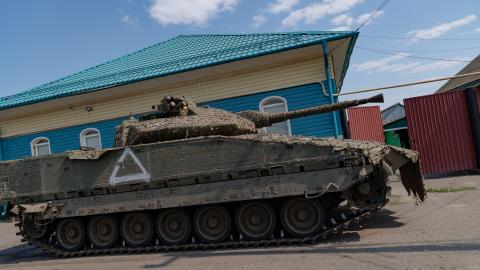It has now been several weeks since Ukrainian forces crossed into Russia’s Kursk Oblast. This move caught many by surprise, including Russia and Ukraine’s allies in the West. It marked the first time in more than 80 years that Russian territory had fallen under the control of an outside power. After initially allocating about 1,000 troops and dozens of armored vehicles for the operation, it is estimated that Ukraine now has several thousand troops and hundreds of armored vehicles operating in Kursk.
This is not the first time that forces aligned with Ukraine have entered the territory of the Russian Federation. In May 2023 and again earlier this year, anti-Putin Russian forces from the Freedom of Russia Legion and the Russian Volunteer Corps entered Russia’s Belgorod Oblast and captured a few border towns. However, it is now clear that Ukraine’s current operation in neighboring Kursk Oblast is different.
Earlier incursions into Russian territory relied on ethnic Russian units and, if Ukrainian military units played a role, it was not made public and was likely minimal. This time, the operation in Kursk Oblast is predominantly being carried out by regular Ukrainian units. Ukrainian flags are being hoisted over municipal buildings and videos on social media show Ukrainian troops engaging with the local population and providing humanitarian support. Many videos show troops speaking in Ukrainian to the local Russian inhabitants, as this region has close cultural ties to Ukraine. Interestingly, the current front lines in Kursk are approximately in the same location as the border between the short-lived Ukrainian People’s Republic and the Bolsheviks in 1918.
Unlike the earlier incursions, which were merely raids with no intention of holding the captured territory, it is clear that Ukraine has every intention of holding onto the Russian territory under its control. Open-source intelligence and commercially available satellite imagery show Ukrainian forces constructing defensive positions.
Ukraine has already achieved most of its short-term objectives with the Kursk operation. Kyiv was in desperate need of a change in the narrative of the war after failing to make much battlefield progress over the past year. Ukraine’s successful, albeit limited, military operation in Kursk has done just that.
So far, it has been able to hold onto the territory it has captured, meaning that any future peace talks could involve trading the areas under Ukraine’s control for Russian-held territory. It is also likely that Ukraine had designs on the Kursk nuclear power plant, hoping to use it as leverage in negotiations for the Zaporizhzhia nuclear power plant, which Russia has controlled since the early days of the war. But so far Ukraine has come up short of achieving this objective. At the time of writing, Ukrainian forces were still about 50 km away from the Kursk plant.
One of Ukraine’s primary goals in entering Kursk may have been to force Russia to withdraw troops from other regions along the front line. In particular, the area around the small Ukrainian town of Pokrovsk in Donetsk has been a focal point of the fighting in recent weeks. The Ukrainians have fought staunchly to hold onto Pokrovsk because important regional rail and road networks converge in the area. However, Russia has been willing to sacrifice greatly to capture the town and is making weekly progress. Moving tens of thousands of Russian troops from one part of the battlefield hundreds of kilometers away to Kursk Oblast could take weeks, if not longer. Therefore, it is too early to tell if Ukraine’s incursion into Kursk will force Russia to pull back in other places, such as Pokrovsk.
Ukraine’s operation in Kursk has exposed a significant vulnerability in Russia’s defenses. It seems almost unbelievable that, after two and a half years of major warfare, Russia left an important section of its border largely undefended, allowing Ukraine to make rapid progress. Russia’s slow response to Ukraine’s Kursk operation also indicates dysfunction within Russia’s internal security apparatus. Local authorities in Kursk, Russia’s internal intelligence services, the Ministry of Defense and the Kremlin have not coordinated their response effectively.
The Russians have taken weeks to mobilize forces to counter the Ukrainian advances and there are reports that Russia has started counteroffensive operations in Kursk. However, Moscow’s progress has been slow. As Russian forces begin to counterattack, the Ukrainians have not only held the front lines in Kursk but have even made isolated tactical gains. If Kyiv intends to use the territory under its control in Kursk as leverage in future peace talks, it will be crucial for Ukraine to avoid overextending its forces in the region.
Ukraine’s Western supporters remain divided on whether the military operation in Kursk was a wise decision. Critics point out that Ukraine has a limited amount of manpower and every soldier and armored vehicle is needed along the most precarious sections of the front line to prevent a Russian breakthrough.
However, proponents of the Kursk operation argue that controlling Russian territory might force Moscow to pull back troops from the front lines. At the very least, Ukraine’s military success has boosted morale and reminded Ukraine’s American and European supporters that it can achieve battlefield victories when given the right equipment and support.
Time will tell whether Ukraine’s gamble was worth it, but it serves as a reminder to expect the unexpected in warfare. Few would have imagined that a war, which Russian military planners had hoped would last only a few days, would result in hundreds of thousands of soldiers dead and wounded and Ukrainian control over a small portion of Russian territory.
As the war enters its third winter, there is no end in sight.
Enjoyed this article? Subscribe to Hudson’s newsletters to stay up to date with our latest content.
















